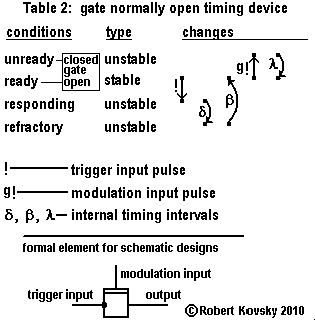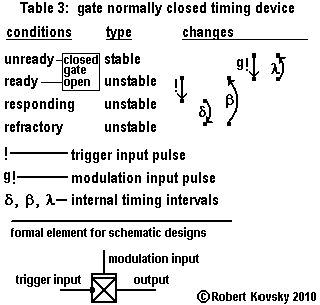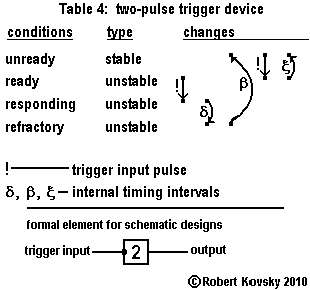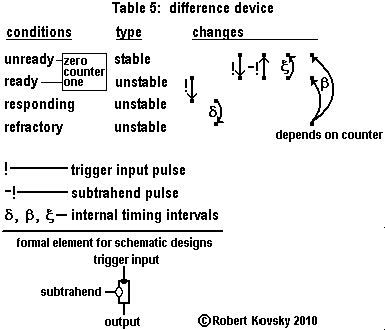Fundamentals of Timing Devices:
Foundations for New Models of Brains
Timing Devices is part of a new technology that has been developed to model activities of brains. Fundamentals of Timing Devices, discussed on this page, is a compact statement of the timing devices system starting from first principles. The intent is to emulate paradigms of mathematics and physical science that have qualities of exactitude, simplicity and integrity.
(...) Fundamentals of Timing Devices, .pdf file (166 kB)
A previous publication, An Ear for Pythagorean Harmonics: Brain Models Built From Timing Devices [web page and .pdf file (466 kB)], applies the timing devices system to auditory experience. There has been a course of development with continual modifications and improvements. (History of timing devices.) Fundamentals of Timing Devices is a re-construction of prior statements of the timing devices system in anticipation of further development.
Preview of materials from Fundamentals of Timing Devices:
- (...) Introduction - Section 1 of the .pdf file
- (...) Tables - engineering forms for 5 core timing devices that integrate the presentation
Introduction
"Timing devices" proposes a new way to investigate brains. An individual timing device acts like a neuron and an assembly of timing devices performs specific brain-like functions. The resemblances are imperfect because timing devices are idealized mental constructs. The author suggests that, despite the defects, timing devices identify principles that can guide investigations into actual brains. The Ideal Gas Law (pV=nRT) is a similar mental construct.
Designs for timing device assemblies look like schematic diagrams used in standard electronic circuits. In circuit diagrams, iconic symbols stand for electronic components that come from a "kit of parts" made up of physical devices. The electronic kit of parts has a "core" that includes resistances, capacitances, signal sources, diodes and bipolar junction transistors. A person builds an electronic circuit by taking parts from the kit and connecting the parts according to a schematic diagram for the circuit. Core parts make up modules that generate and process important classes of signals, e.g., sine waves and their combinations. Additional devices such as photo-sensors and memory devices supplement the core.
The features of standard electronic circuits described in the preceding paragraph re-appear in the timing devices system. At this time, the core members of the timing devices kit of parts are:
- the primal timing device;
- the gate normally open timing device;
- the gate normally closed timing device;
- the two-pulse trigger timing device; and
- the difference device.
This presentation of the core timing devices is developmental. The primal timing device is a minimal unit and is the point of origin. The step from the primal device to the gate normally open device resembles the step from the semiconductor diode to the bipolar junction transistor (pnp or npn). Development of later devices involves further additions and modifications.
All devices and designs are conceptual; there are no plans for working models.
A tabular form is used to integrate the presentation of the five core timing devices. The author suggests that the integrated tabular form provides a solid foundation for further development of the timing devices system.
(...) Fundamentals of Timing Devices, .pdf file (166 kB).
Tabular Forms
A set of tabular forms organizes the core devices of the timing devices system.

|

|

|

|

|
(...) Fundamentals of Timing Devices, .pdf file (166 kB).
History of Timing Devices
The timing devices system was developed from Quad Nets, discussed on a separate website (...). I published the Quad Nets Model online in October of 2006 and posted a notice on the "neurodudes.com" blog. Readers of the neurodudes blog offered criticism and suggestions.
In brief, a Quad Net "device part" is made up of a large number (e.g., thousands) of elemental device units that are organized through "tiling" principles and collectively activated; and a Quad Net device part is a model of a "neuronal group" that is a chief organizing unit in brains. Although resembling prior physical paradigms, the proposed device models are independent conceptions and are fully presented in my publications. The central principle of the Quad Net Model - the principle of Shimmering Sensitivity that I suggest resembles human consciousness - is embodied in collective activity. As stated in the Quad Net publications, such collective activity cannot be tracked mathematically (at least as far as I know) and Images of designs and operational charts are the chief means used to describe the system.
In a dialogue with me that extended over several messages, Eric wrote:
It would really help if you dissected an individual 'tial' mathematically. That is, what rules do they follow? What are the rules for how they interact with one another? Is there an example of a computation that they can perform? E.g., xor.
...
Bob: without an equation to describe how an individual element works, it's impossible for me to say anything more. Even if you need six to get a cycle, it would be very helpful to know what is cycling, what the rules governing the individual elements of the cycle. It is usually pedagogically most useful to start simple, with equations that govern how an individual element (whether it be neuron, capacitor, etc) works, and then build up slowly to more interesting behavior.
...
[Eric noted comparisons to:]...cellular automata, but the rules governing the behavior of individual cells is quite explicable. My main point is, that as a sociological fact, few people will read or understand your theory unless you take what you call the 'atomic-molecular' approach.
...
also it would be good to fill out in more detail the input-output transform being implemented by an individual element: a drawing that specifies the inputs, outputs, and the transform between the two.
Mike wrote:
Here's my advice, from 20 years in the industry.
- Define what each unit does.
- Describe how the units interact.
- Show that the interaction causes the units to generate a representation.
The "six" units Eric referred to were obviously those shown in connection with the Simple Cycler device assembly in § 4.a of the Quad Nets paper. Following the advice of Eric and Mike, the elemental devices in the Simpler Cycler became primal timing devices with reductions as they suggested. Section 4.e of Quad Nets involved "one pulse triggers" and "two pulse triggers" that reduced to the "one-pulse trigger rule" and the "two pulse trigger rule" for timing devices. Controller operations discussed in § 4.f had been conceived with prior gate devices in mind, namely, relays, vaccuum tube triodes and bipolar junction transistors; and gate timing devices devices followed directly.
- I first published the original Timing Devices paper online in February of 2007. (..., .pdf file, 832 kB)
- Thereafter, the original paper underwent a course of development and was published in its final version in June of 2008 (..., .pdf, 833 kB) on the web page "Timing Devices or why brains are not computers" (...).
- As shown on the web page, musical experience appeared suitable for modeling with timing devices. In February of 2009, I conceived of connections between harmonies and timing device assemblies that developed into "An Ear for Pythagorean Harmonics: Mathematical Processing in Brain Models Built From "Timing Devices" (..., .pdf, 212 kB) published in April of 2009 on the web page, "Shimmering Silences in Beautiful Music / An inquiry into the nature of personal experience" (...).
- The Ear for Pythagorean Harmonics became a vehicle for further development, leading to publication in December of 2009 of "An Ear for Pythagorean Harmonics: Brain Models Built From Timing Devices" (..., .pdf, 460 kB) on a web page with the same name (...).
- In retrospect, the main work in developing timing devices was devoted to the "difference device." The original paper used the concept of a difference device to run a rudimentary engineered organism. Subsequent publications progressively sharpened and extended attempts to construct a device performing "exact" subtraction and to employ it in applications. The December 2009 publication achieved further advances but at a cost of introducing "algorithmic" processes that were foreign to the Quad Net origins of the devices.
- Fundamentals of Timing Devices resolves the earlier difficulties and re-establishes the core timing devices on the basis of the original Quad Net Model.
- In that the original timing devices were reductions from the collective Quad Net Model, there appears to be a development path for Quad Nets involving core timing devices and their assemblies modified for organization through tiling principles and collective activation.
(...) Fundamentals of Timing Devices, .pdf file (166 kB)
Related Works by the Author
Timing Devices is part of the my larger work, where device designs for brains are the basis of a psychological model and the psychological model is used to investigate institutional activities, including physics and natural science, the laws of the courts and the Christian religion. The focus of interest in the larger work is personal freedom, especially as expressed through choices and selections made by persons in institutional situations. Of course, we exercise freedom in wilderness too, but institutional situations are more susceptible to analysis.
The engineering and scientific works set forth principles of device design that can be developed in several directions. Writings about psychological, philosophical, institutional, personal and spiritual matters are more tentative and even sketchy – but they provide long-range motivation and have suggested particular inventions and pathways of development.
I. Other Engineering and Scientific Works
- Quad Nets (2006)-- Quad Nets is the chief engineering and scientific presentation of my "device models of brains." Timing Devices, discussed here, began as a simplified version of the Quad Net Model.
- Quad Nets website -- separately organized
web page on the full paper titled Quad Nets: Material Foundations for Thermal Device Models of Brains
download Quad Nets paper. (.pdf format, 1.1 Mb)
The separate web page, Dancer - Shimmering Gaits of a Six-Legged Engineered Organism link, contains a proposed series of projects for construction of systems for engineered organisms (artificial animals) to be built from timing devices and Quad Net assemblies, starting with a "Utricle" that detects the orientation of an organism with respect to gravity and progressively leading upwards to a six-legged organism that uses a variety of coordination patterns ("gaits") in attempts to navigate a broken and obstructed terrain.
II. Philosophy of Science
Conventional brain science affirms the principle "brains are computers" in the disciplines of "computational neuroscience" and "artificial intelligence." "Brains are computers" is part of a belief system that I call the Mechanical Cosmology and that includes other propositions: "all things are made of atoms" and "the Universe is governed by laws of physics, like the law of conservation of energy."
Beliefs about atoms and laws of physics have been developmentally productive and wonderfully fruitful in practical ways – in contrast to "brains are computers" – but all such beliefs false and misleading. There are no "atoms." Atoms are mental constructions and they do not appear in reality. It is possible to buy materials, such as minerals, metals, refined chemical reagents, vegetable materials, animal materials and synthetic materials; but it is not possible to buy "atoms." The material that is closest to "atoms," refined helium, shows complex, collective, "non-atomic" properties when the temperature gets very low and the helium liquifies.
Energy is never "conserved." "Conservation of energy" is an ideal that is never attained, although billiard tables, vacuum chambers and ball bearings rather approach it and make exact calculations possible under some circumstances.
Physicists believe that all of reality is made up of particles and laws of physics. Some parts of reality are well modeled by methods based on this belief but other parts of reality – e.g., the reality of persons and the reality of conflicting principles of social organization – cannot even be recognized. The physicists' belief is formed through study of imaginary conservative systems of atoms that can never be realized and that do not apply at all to situations that are most important to persons living their lives.
My works on these subjects are not as compactly organized as my engineering and scientific works and the themes run through many diverse works
Works related to Philosophy of Science
Please see a separate web page, "Facts About Snowflakes," about the generation of snowflakes from gaseous water vapor. Snowflakes can be beautifully symmetrical. Physicists are unable to account for this phenomenon because the proposed atomic processes are independent of one another and distant from each spatially. I argue that the attempt to explain the phenomenon by means of atomic processes is a failure. This failure is exemplary of the failures of physics to explain classes of phenomena of phase changes, of which the change from water to ice is the most familiar. I hold that important brain activities are phase changes and outside the reach of the Mechanical Cosmology.
A Patchwork of Limits: Physics Viewed From an Indirect Approach (2000), a .pdf file (157 kB), is discussed on a separate web page The paper is a statement of my "alternative view of physics" that includes technical analysis of the thermodynamic critical state, the conceptual basis of Quad Nets.
A broad statement of my alternative view accessible to the lay reader, with a critical analysis of conventional physics, is in § 6 of "An Objective Kind of Freedom," an archival paper in the form of a .pdf file (618 kB.). The paper was published online in January of 2005 and the first six sections were foundational of my development of Quad Nets later in the year.
(return to top of page).
III. Large-scale Works
-
- Testimony of Freedom
- A separate website, under development, that establishes scientific and engineering foundations for investigations into social and spiritual matters.
- Embodiment of Freedom
- A separate website that was a prior stage of development, now superseded in large part by Testimony of Freedom. This site contains the Archive of my work that was done prior to May of 2005 and that led up to Quad Nets.
first published May 21, 2010
Copyright © 2010 Robert Kovsky









